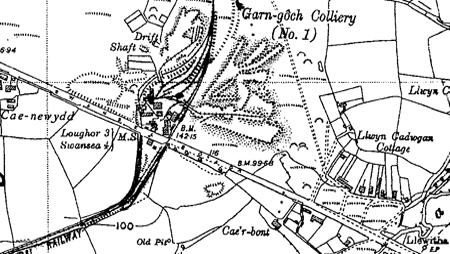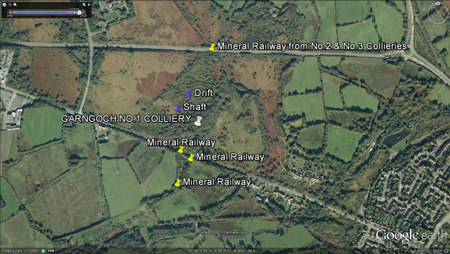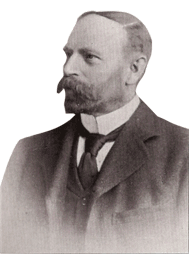

The Fforestfach History Website
Collieries - Garngoch N1
Garngoch Colliery No.1
Location: Latitude: 51.654199, Longitude: -4.007172 or Map Grid Reference: SS6124696953
John Glasbrook *(1816-1887) Colliery Owner - Contemporary Portraits, Men & Women of South Wales & Monmouthshire", (Western Mail, 1897) |
Garngoch No.1 Colliery Area - Google Earth 1945 |
|
|
 | |
 |
 |
|
| Garngoch No.1 Colliery Area reproduced from (1936 -1947) Ordnance Survey map. | Garngoch No.1 Colliery Area - Google Earth 2009 |
|
Garngoch my understanding, meaning "red cairn", explanation: Garn or Carn (mound or cairn) from bronze age burial and goch,
meaning red coming from the Battle of Gower 1136. The area is also linked with Roman times.
The Battle of Gower 1136 memorial stone can be seen - follow sign post from Hospital Road, Garngoch.
Source |
Index |
Area |
Date |
Details |
|---|---|---|---|---|
(RL) |
P43 |
THE COLLIERS OF THE SWANSEA. |
1870 |
The Garngoch No. 1 Pit, 1.5 miles north-east of Gowerton railway station. It struck the Swansea Five-Feet seam at a depth of 205 yards. |
(C) |
K60 |
SOCIAL, LOCAL DIGNITARIES |
1879 Nov. 14 |
Duke of Beaufort visits Garngoch Colliery, Steel Works, Docks and Gas Works while in Swansea. P5 |
(RL) |
P44/5 |
THE COLLIERS OF THE SWANSEA. |
1880 July 7 |
Colliery Explosion: At the time, the mine was being worked with naked lights. Collier victims: John Lewis, 30 years, Daniel Rees, 29 years, Thomas Hugh 29 years, William Morgan 33 years, David Rosser, 21 years, Daniel Watkins aged 14 years collier's boy. The mine was inspected before and after the explosion and no gas was found. The jury brought a verdict of 'Accidental Death'. Safety lamps were recommended and the owner was reported to have acted on this recommendation. |
(C) |
J71 |
MINING AND INDUSTRY, SERVICE. |
1888 Mar.16 |
Swansea Sanitary Authority: Mr Glasbrook & Garngoch Colliery water. |
(C) |
J22 |
MINING AND INDUSTRY, COAL. |
1899 Nov.10 |
Carngoch (Garngoch) & Gorseinon Colllieries dispute: Results of talks put to workers. Sliding scale committee of coal owners. |
(C) |
J22 |
MINING AND INDUSTRY, COAL. |
1899 Nov.10 |
Dispute at Carngoch (Garngoch) & Gorseinon Collieries: John Williams, miner's agent, meets John & Isaac Glasbrook (owners). P7 |
(C) |
J22 |
MINING AND INDUSTRY, COAL. |
1899 Nov.10 |
Gowerton & District: Wages dispute at Carngoch (Garngoch) & Gorseinon collieries of messrs Glasbrook Brothers, Limited. P7 |
(NTL) |
P68/9 |
STORY OF SWANSEA D & V |
1907 |
The manager of No. 1 Colliery was Charles Richard (1846-1928) retired, colliery workmen made him a presentation of a gold watch as a mark of admiration as a mine manager. |
(RL) |
P43 |
THE COLLIERS OF THE SWANSEA. |
1908 |
Managed by J.W. Evans. Employed 212 / 76 men. Closed in that year. |
(RL) |
P43 |
THE COLLIERS OF THE SWANSEA. |
1913 |
No.l Pit was reopened. Employed 520 men. Manager J.W. Evans. |
(RL) |
P43 |
THE COLLIERS OF THE SWANSEA. |
1914 |
The pit was originally rectangular in shape. When they hit the Six-Feet seam in March at a depth of 259 yards it was altered to a 14 feet diameter. |
(RL) |
P43 |
THE COLLIERS OF THE SWANSEA. |
1915 |
No.l Pit employed 160 men. |
(RL) |
P43 |
THE COLLIERS OF THE SWANSEA & STORY OF SWANSEA D & V |
1916 |
A drift was used to bring the coal 150 yards from No.1 Pit to the east. A slant was used for trams to brought to the service and the pit utalised for ventalation purposes. A drift can be seen on 1945 & 2009 Google Earth images, also known as Garngoch No.4.This closed in 1919. |
(RL) |
P43 |
THE COLLIERS OF THE SWANSEA. |
1916 |
The No.l employed 135 men and was managed by W. Morgan. |
(RL) |
P43 |
THE COLLIERS OF THE SWANSEA. |
1918 |
Mr W. Davies was the manager and employed 295/103. |
(RL) |
P43 |
THE COLLIERS OF THE SWANSEA. |
1919 |
The No.l employed 346 men and was managed by W. Davies. |
(NTL) |
P82 |
STORY OF SWANSEA D & V |
1921 |
Photo: Bringing the horses to surface during the 1921 strike, collier, horses and surveyor Mr T. Bryn Richard. |
(RL) |
P43 |
THE COLLIERS OF THE SWANSEA. |
1923 |
Employed 430/ 85 men, with the manager being W. Davies. |
(RL) |
P43 |
THE COLLIERS OF THE SWANSEA. |
1927 |
No.l Employed 435 men under J. Tanner. |
(RL) |
P43 |
THE COLLIERS OF THE SWANSEA. |
1930 |
Mr. Tanner employed 355 /61 men in the No.l Pit. |
(RL) |
P43 |
THE COLLIERS OF THE SWANSEA. |
1934 |
The No.l Pit employed 289/50, the manager being T. Roberts. |
(RL) |
P44 |
THE COLLIERS OF THE SWANSEA. |
1947 |
Nationalisation of Garngoch was placed in the National Coal Board's, South |
(RL) |
P44 | THE COLLIERS OF THE SWANSEA. |
1952 Apr.18 |
Garngoch No.1 Pit was closed by the National Coal Board. |
NOTES: AREA COLLUM (etc.)
- MINING AND INDUSTRY, SERVICE INDUSTRY, WATER - MINING AND INDUSTRY, COAL MINING, PONTARDULAIS, LOUGHOR, GORSEINON - THE COLLIERS OF THE SWANSEA AND SWANSEA VALLLEY GENERAL AREAS by Ray Lawrence BSc. 2008 - (NTL), STORY OF SWANSEA D & V Norman Lewis Thomas (The Story of Swansea Districts and Villages Volume II Parts IV-VIII with Abridged Volume I Parts I - III, 1969)
________________________________________________________________________________________________
The No.l Pit worked - Swansea three, four, five and six foot seams.
Workers: e.g. 355 /61 = 355 underground and 61 on the surface.
The names of collieries would often change with ownership or re-openings, the coal seam name would sometimes follow suit. ________________________________________________________________________________________________
QUOTE
"The railway line from Gowerton Station (G.W.R) to Garngoch Collieries built by John Glasbrock in the early 1870's, afterwards managed by his sons Messrs. Glasbrock Brothers, runs close up to the south side of the old canal for a distance of approximately 650 yards. This railway line, as far as Garngoch No.1 Colliery, was doubtlessly surveyed and constructed under the supervision of Thomas Richard, Sen., and extended across Garngoch Common during 1855-86 by his son when the No.2 Pits were being sunk alongside the road from Penllergaer to Gorseinon."
Norman Lewis Thomas, The Story of Swansea Districts and Villages Volume II Parts IV-VIII with Abridged Volume I Parts I - III, 1969, page110
REFERENCE:
Gower - Vol. 21. 1970 The beginning of the Coal Industry in Loughor. * date source: Glanmor Williams (edited), Swansea an Illustrated History, 1990, p51. "Garngoch" was used to filter the Cambrian index as best as possible with the information available. (C) Cambrian [web filtered] | Available from the Swansea County Hall. |
________________________________________________________________________________________________
*A huge thank you to Dave Arnold for all his help with the Collieries* |
Thank you to the City & County of Swansea for all your help and support. |
